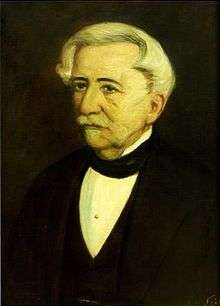Aigio
| Aigio Αίγιο | |
|---|---|
|
The town of Aigio | |
 Aigio Location within the regional unit 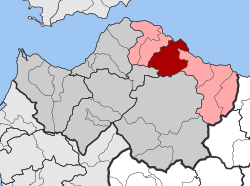 | |
| Coordinates: 38°15′N 22°05′E / 38.250°N 22.083°ECoordinates: 38°15′N 22°05′E / 38.250°N 22.083°E | |
| Country | Greece |
| Administrative region | West Greece |
| Regional unit | Achaea |
| Municipality | Aigialeia |
| • Municipal unit | 151.101 km2 (58.340 sq mi) |
| Elevation | 61 m (200 ft) |
| Population (2011)[1] | |
| • Municipal unit | 26,523 |
| • Municipal unit density | 180/km2 (450/sq mi) |
| Time zone | UTC+2 (EET) |
| • Summer (DST) | UTC+3 (EEST) |
| Postal code | 251 00 |
| Area code(s) | 2691 |
| Vehicle registration | ΑΧ,AZ |
| Website |
www.aigialeia.gov.gr www.aigio.gr |
Aigio, also written as Aeghion, Aegion, Aegio, Egio, (Greek: Αίγιο, pronounced [ˈeʝo]) is a town and a former municipality in Achaea, West Greece, Greece. Since the 2011 local government reform it is part of the municipality Aigialeia, of which it is the seat and a municipal unit.[2] The municipal unit has an area of 151.101 km2.[3] Its population is around 26,000. Aigio is a port town on the Gulf of Corinth.
Geography
The southwestern part of the municipality consists of the foothills of the Panachaiko mountain. The river Selinountas flows into the Gulf of Corinth in Valimitika, 5 km east of Aigio town centre. The town centre is immediately on the coast, between the ferry port and the railway station. Fishermen bring their catches from a night of fishing into the markets every morning. Sites of interest include a Mycenean house dating back to ancient times, located near the cliffs. There is a hospital southwest of the town centre. Residential houses surround the city and flourish in the western part of Aigio, making it a popular destination for Athenians and others alike. Orange and lemon trees grow in most yards, and irrigation from small, open canals keeps the city greener than most.
History
Antiquity
Before the founding of the city, the area had a Neolithic settlement. The city of Aigion was founded during Homeric times and became part of the first Achaean League since around 800 BC. The city had several Olympic winners including Xenophon, Ladas (stadion race), Athenodorus (Αθηνόδωρος) (stadion race), Straton (Στράτων) (pancration and wrestling). After the disaster of Helike, which was destroyed by an earthquake and buried by a tsunami in 373 BC, Aigion took the territory of the neighbouring city. The ruins of Helike (sometimes called "The Lost Atlantis") were discovered in 2000 off the coast in the Corinthian Gulf and archeologists are excavating the site.[4]
From 330 BC Aigion was for fifty years under the Kingdom of Macedon, but around the year 275 BC the people expelled the Macedonian garrison and the city joined the new Achaean League. With the famous temple of Zeus Homarios, Aigion became the Achaean assembly place and remained their capital until the Roman conquest in 146 BC. After the annexation of Achaia, the Romans removed the wall of the city and Aegium lost its importance.
Byzantine era
After the division of the Roman Empire in 395 AD, Aegium became a part of the Eastern Roman Empire and later the Byzantine Empire. Later (it is unclear when exactly the change of name happened) it was renamed Vostitsa (Βοστίτσα). In the Chronicle of the Morea it is first mentioned with this new name. The origin of this name is unclear. Some scholars interpret the name as having a Slavic origin. For example, the German linguist and slavisist Max Vasmer gives two possible interpretations,[5] one from the word Voščica (Voštane, sloven. Vošče) and one from the word ovoštь="fructus". Famous Greek byzantinist Dionysios Zakythinos gives a similar interpretation.[6] Christos Coryllos in his detailed book "Χωρογραφία της Ελλάδος, Νομός Αχαϊας" gives another similar interpretation. He writes that after the plague epidemic there were peaceful arrivals of avars or slavs shepherds and one of their leaders had the name "Vostitzas" from whom later the town took his name.[7]
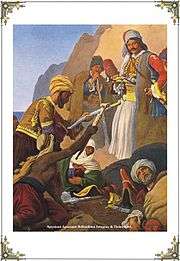
Frankish/Ottoman era
It was captured by the Crusaders in the early 13th century and became the seat of a barony of the Principality of Achaea. In the early 15th century, it was conquered by the Despotate of the Morea, and in 1459 was conquered by the Ottoman Empire, who ruled it, with brief interruptions by the Venetians from 1463 until 1470 and from 1685 until 1715, until the outbreak of the Greek War of Independence. It was captured by the Greek rebels on 26 March 1821, becoming the first town to be liberated. After Greek Independence, the town was officially renamed to its ancient name.
Modern era
On June 15, 1995, a serious earthquake destroyed many buildings and damaged roads in the downtown and southwestern sections,[8] with a number of casualties. The earthquake shattered Aigio: small memorials are found throughout the city, with candles aglow day and night to remember the victims. The mountainous countryside near Aigio was severely damaged by the 2007 Greek forest fires.[9]
Landmarks and sights
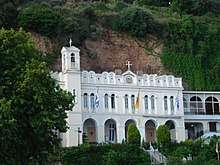
- One of the most notable attractions of Aigio is the church of Panagia Tripiti. It is a national sacred shrine dedicated to the Mother of God the Life Giving Spring. It is built on a steep cliff almost 30 meters high, near to sea, in a beautiful landscape full of cypresses and pine trees.
- The church of Panagia Faneromeni (inaugurated in 1914) which is the cathedral of Aigio and it is the work of architect Ernst Ziller. The interior is decorated with paintings of Constantine Fanelis.
- The Archaeological Museum of Aigio which originally housed the municipal market of Aigio.It is a work of the famous architect Ernst Ziller and it was built in 1890.
Transport

Until May 2011 there used to be a ferry service from the port of Aigio to the north-eastern mainland city of Agios Nikolaos (not to be confused with the Cretan city of the same name). Ferry service was very small and only had three Ferries daily. The trip was 45 minutes long. The shipping company that operated the ferry boat announced on May 2011 the stop of the ferry service due to financial reasons.[10] The port is crossed by rail which is not in operation anymore [11][12] since OSE announced the suspension of all the rail service in the Peloponnese on January 2011. A new double and electrified railway line is under construction as well as a new railway station at the east outskirts of the city. According to OSE, it is expected that in the year 2019, the city of Aigio will be again connected by train to Athens and Corinth.[13] The city can be accessed by Motorway 8 (Greece) (Athens-Corinth-Patras) and Greek National Road 31 (Aigio - Kalavryta).
Infrastructure and economy
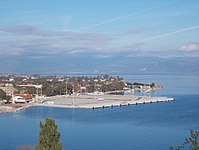
Aigio, along with Patras and Piraeus, was one of the main export hubs for Corinthian raisins since the 19th century.[14][15] In the book "Geography of Greece - Achaia" of Christos Coryllos (1903)[16] it is mentioned that annually at the area of Aigio were produced 7.5-10 million Kgs of raisins and 600 thousand kgs of olive oil. Today the port is used as a fruit import hub for Chiquita Brands International mainly for import of bananas.[17] A new 256 m long pier northwest of the existing port was inaugurated on 7 August 2013. The whole project cost 8.6 million Euros and is intended to enhance trade and tourism opportunities for the city.[18][19] Aigio houses two branch departments of the Technological Educational Institute of Patras, the department of Physiotherapy and the Optics and Optometry department.[20] The Aigio General Hospital is situated a few kilometres out of the town and has a capacity of 100 beds. The Hospital performs the greatest number of Laparoscopic surgeries in Greece while more than 50,000 people are examined on a yearly basis.[21] Regarding sport facilities, Aigio has a football stadium called "Municipal Stadium of Aigion" which has a capacity of ~7,000 (4,500 seats).[22] It was built in 1951 and the latest renovation was in 1999. Aigio was missing for many years any basic facilities for water sports like swimming or water polo, but according to local media a new outdoor swimming pool is already constructed and soon is going to be given for use.[23]
Subdivisions
The municipal unit Aigio is subdivided into the following communities (constituent villages in brackets):
- Aigio (Aigio, Agios Nikolaos, Sotir, Foniskaria)
- Chatzis
- Dafnes
- Digeliotika
- Kouloura
- Koumari
- Kounina (Kounina, Agia Anna, Pelekistra, Petrovouni)
- Mavriki (Ano Mavriki, Agios Ioannis, Kato Mavriki)
- Melissia (Melissia, Lakka, Pyrgaki)
- Paraskevi
- Pteri (Pteri, Achladea, Agios Andreas, Agios Panteleimonas, Boufouskia, Kato Pteri)
- Selinounta
- Temeni
- Valimitika
Historical population
| Year | Municipal district | Municipality |
|---|---|---|
| 1981 | 20,955 | - |
| 1991 | 22,178 | 28,903 |
| 2001 | 21,255 | 27,741 |
| 2011 | 20,664 | 26,523[1] |
Mayors
- Anastasios Lontos
- Dimitrios Meletopoulos
- Dimitrios Oreinos
- Georgios Meletopoulos
- Inokentios Romaniolis
- Diomidis Polychroniadis
- Andreas Michalopoulos
- Sotirios Messinezis
- Athanassios Farazoulis
- Konstantinos Kanellopoulos
- Spyros Panagiotopoulos
- Leonidas Petropoulos
- Panagos Lyrintzis
- Efthymios Gatos
- Christos Lambouris
- Georgios Kanellopoulos
- Polychronis Noukopoulos
- Polychronis Polychroniadis
- Ioannis Stavropoulos (until 1936)
- Sotiris Stavropoulos (1936–1941), (1951–1952)
Notable people
- Andreas Londos, fighter in the Greek War of Independence
- Dimitrios Meletopoulos, fighter in the Greek War of Independence
Newspapers
Sporting clubs
- Panegialios F.C., second division
- Aris Valimitika
- Egieas Egion
- Olympiakos Aigio
- T.A.D. '93 Aigiou
- Thyella Aigio
- Straton Aigiou.
Gallery
 City of Aegio as seen from the municipal beach of Alyki.
City of Aegio as seen from the municipal beach of Alyki.- Panagiotopoulos mansion.
 The sacred shrine of Panagia Trypiti
The sacred shrine of Panagia Trypiti- The Heroon. The inscription reads an epigram of Tyrtaeus.
 Aigio municipal stadium
Aigio municipal stadium
See also
References
- 1 2 "Απογραφή Πληθυσμού - Κατοικιών 2011. ΜΟΝΙΜΟΣ Πληθυσμός" (in Greek). Hellenic Statistical Authority.
- ↑ Kallikratis law Greece Ministry of Interior (in Greek)
- ↑ "Population & housing census 2001 (incl. area and average elevation)" (PDF) (in Greek). National Statistical Service of Greece. Archived from the original (PDF) on 2015-09-21.
- ↑ Stewart, Iain (25 October 2000). "Echoes of Atlantis". Theguardian.com. Retrieved 18 August 2017 – via The Guardian.
- ↑ Die Slawen in Griechenlad, Verlag der Akademie der Wissenschaften, Berlin 1941
- ↑ Διονύσιος Α. Ζακυθηνός, Οι Σλάβοι εν Ελλάδι. Συμβολαί εις τήν Ίστορίαν τοϋ Μεσαιωνικού Ελληνισμού, Αθήναι, Αετός, 1945 (αναφέρει το εξής "Βοστίτσα:Τόπος οπωροφόρος"
- ↑ Χρ. Κορυλλου, Χωρογραφίας της Ελλάδος, Α´, Νομός Αχαϊας, Αθήναι, 1903
- ↑ Journal of Geodynamics Vol. 26, Issues 2-4, 1998, Pages 487-499 "Egio earthquake (15 June 1995): An episode in the neotectonic evolution of Corinthiakos Gulf"
- ↑ "Greek fires blamed on 'culture of arson'". Telegraph.co.uk. Retrieved 18 August 2017.
- ↑ "Σταματά στις 2 Μαΐου το φέρυ μποτ Αιγίου - Αγίου Νικολάου". Thebest.gr. Retrieved 18 August 2017.
- ↑
- ↑ Naftemporiki (23 December 2010). "ΤΡΑΙΝΟΣΕ: Διακοπή δρομολογίων και αύξηση κομίστρων". Naftemporiki.gr. Retrieved 18 August 2017.
- ↑ , METKA signed contract for the completion of Kiato-Rododafni Railway project within 24 months, (September 2014)
- ↑ "Athens News article 10 October 2010 - Hidden history: Of currants and crisis". Athensnews.gr. Archived from the original on 22 March 2013. Retrieved 18 August 2017.
- ↑ "EGHIO (Town) ACHAIA - GTP". Gtp.gr. Retrieved 18 August 2017.
- ↑ Χρ. Κορυλλου, Χωρογραφία της Ελλάδος, Α´, Νομός Αχαϊας, Αθήναι, 1903
- ↑ "Θ. Γκλίνος: "Δεν φτάνουν οι μειώσεις τιμών στους καταναλωτές"". Zougla.gr. Retrieved 18 August 2017.
- ↑
- ↑ Σπηλιωτοπούλου, Πέπη. "Υπεγράφη το πρακτικό διοικητικής παραλαβής για τη χρήση του έργου της ολοκλήρωσης του νέου λιμένα Αιγίου - Filodimos.gr". Filodimos.gr. Retrieved 18 August 2017.
- ↑ "ΤΕΙ Δυτικής Ελλάδας - Τμήμα Οπτικής και Οπτομετρίας". Optiki.teipat.gr. Retrieved 18 August 2017.
- ↑ "Home". Gnaigio.gr. Retrieved 18 August 2017.
- ↑ http://stadia.gr/aeghio/aeghio-gr.html
- ↑ Article in daily newspaper "Peloponnisos" (in Greek) about the operation of the new swimming pool, includes a photo of the facilities (28/01/2018)
External links
| Wikimedia Commons has media related to Aigio. |
- Official website of the municipal unit of Aigio (in Greek)
- Official website of the municipality of Aigialeia (in Greek)
- Aigio Port Authority (in Greek)
- General Hospital of Aigio
- Tourist guide of Aigialeia (in English)
- The directory of the city of Aigio (in Greek)
- Blog regarding the city of Aigio (in Greek)
